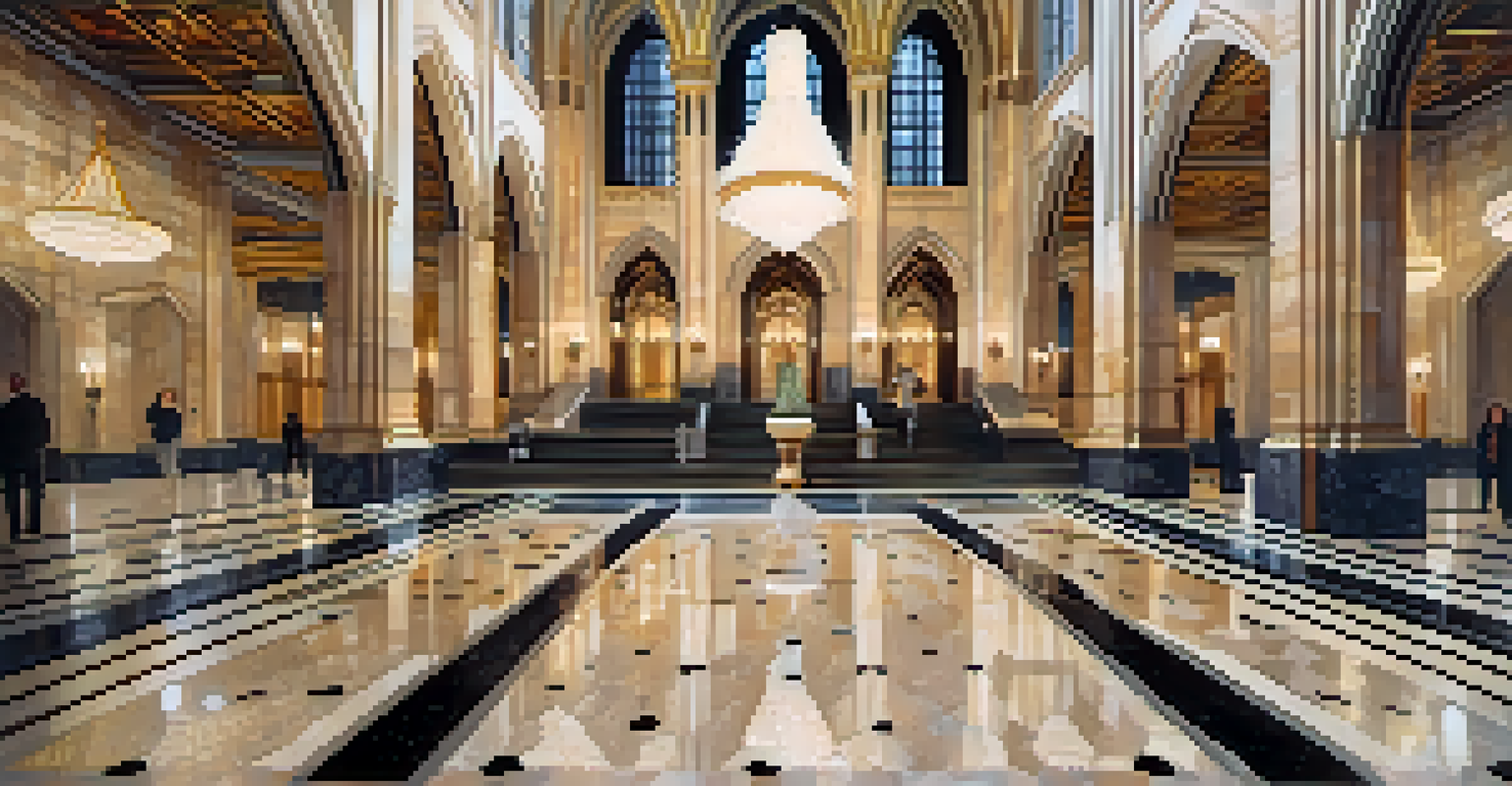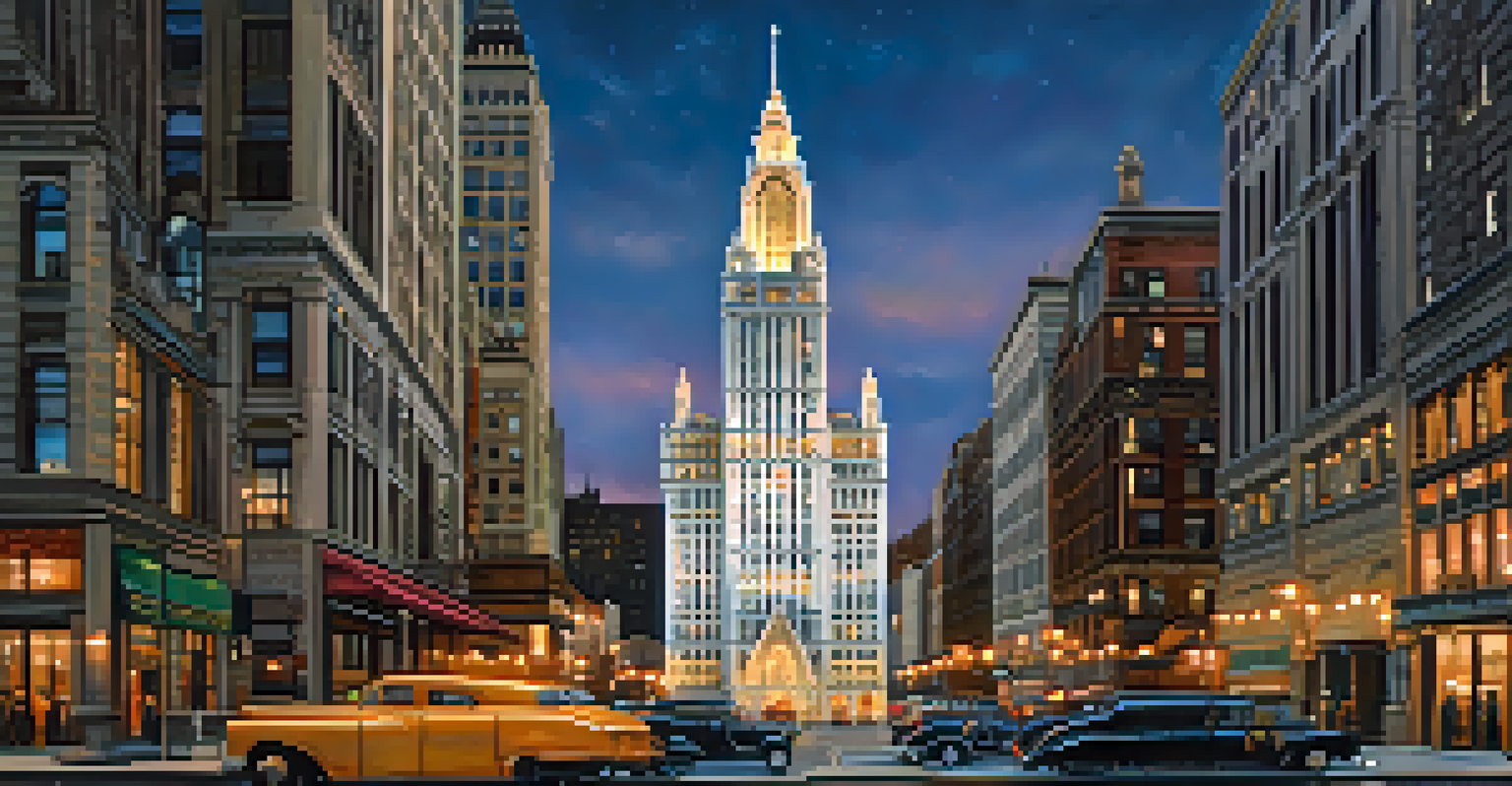The Woolworth Building: A Skyscraper with a Rich Past

The Birth of the Woolworth Building in the Early 1900s
The Woolworth Building, often dubbed the 'Cathedral of Commerce', was completed in 1913 and stands as an iconic symbol of New York City. Designed by architect Cass Gilbert, it was commissioned by Frank Woolworth, the five-and-dime store magnate, who envisioned a towering structure to represent his retail empire. At the time of its completion, it was the tallest building in the world, a title it held for 17 years.
A great building must begin with the unmeasurable, must go through measurable means when it is being designed and in the end must be unmeasurable.
Constructed with a distinctive neo-Gothic style, the Woolworth Building boasts intricate terracotta detailing and a stunning 30th-floor lobby that feels like stepping into a grand cathedral. The building's height and design not only showcased Woolworth's success but also represented the ambition of America during the early 20th century. It was a time when skyscrapers were rising, and the skyline of New York was beginning to transform.
Woolworth's vision was not only to create a headquarters for his business but also to make a statement about the rise of retail and commerce in the modern world. The building's completion was celebrated with a grand opening event that drew crowds, marking a pivotal moment in architectural history and setting the tone for skyscraper design in the years to come.
Architectural Marvel: Design and Features
The Woolworth Building is a masterpiece of design, showcasing the Gothic architectural style with its soaring spires and ornate details. Standing at 792 feet, its height was a bold statement of ambition and innovation, capturing the spirit of the age. The building’s base features an elaborate façade with intricate carvings, making it a standout among its contemporaries.

One of the most striking features is the lobby, often regarded as one of the most beautiful in the world. Adorned with vaulted ceilings, shimmering mosaics, and a grand staircase, it creates an inviting atmosphere that transports visitors to another era. The use of rare materials, including onyx and marble, further enhances its opulence and elegance.
Woolworth Building: A Historic Icon
Completed in 1913, the Woolworth Building stands as a symbol of New York's architectural ambition and commercial success.
The building's design not only focused on aesthetics but also on functionality. It was one of the first skyscrapers to incorporate the steel-frame construction method, allowing for greater height and stability. This innovative approach paved the way for future skyscrapers, solidifying the Woolworth Building's legacy as an architectural pioneer.
Cultural Significance Through the Decades
Over the years, the Woolworth Building has been more than just an office space; it has become a cultural icon. Its unique silhouette has been featured in countless films, television shows, and artworks, further embedding it in the fabric of American culture. The building has witnessed significant historical events and has been a backdrop for many stories that define New York City.
Architecture is the learned game, correct and magnificent, of forms assembled in the light.
In the 1920s, the building was a hub for business and commerce, attracting various companies and professionals. It became a symbol of prosperity during the Roaring Twenties, reflecting the economic boom of the era. However, as times changed and the economy fluctuated, the building faced various challenges but always managed to retain its status.
Today, the Woolworth Building stands as a testament to resilience and adaptation. While it has transformed over the years, it continues to hold a special place in the hearts of New Yorkers and visitors alike, serving as a reminder of the city’s rich history and architectural evolution.
The Woolworth Family Legacy
Frank Woolworth's legacy extends far beyond the building itself; his vision and entrepreneurial spirit shaped the retail landscape of America. The Woolworth chain, known for its affordable merchandise and variety, became a staple in cities across the country. Frank's success story is often cited as an example of the American Dream, inspiring generations of entrepreneurs.
The Woolworth family remained involved with the building and the business for decades, playing a significant role in its operations and maintenance. Over time, however, as the family’s retail empire began to decline, the building transitioned into a multi-tenant office space, adapting to the changing economic landscape. Despite these shifts, the family’s influence on the building and its history remains.
Architectural Masterpiece
Its neo-Gothic design features an ornate lobby and innovative steel-frame construction, making it a pioneer among skyscrapers.
Today, the Woolworth Building is a reminder of not only architectural brilliance but also the impact of one man's vision on American culture. Frank Woolworth's legacy is preserved within its walls, serving as a source of inspiration for those who walk through its grand entrance.
Restoration and Preservation Efforts
In recent years, the Woolworth Building has undergone significant restoration and preservation efforts to maintain its historic charm. As a designated National Historic Landmark, it’s crucial to protect its architectural integrity and ensure that future generations can appreciate its beauty. These efforts have included careful restoration of the lobby and exterior, highlighting the craftsmanship that went into its original construction.
Preserving such an iconic structure comes with challenges, especially when modernizing its facilities to meet contemporary needs. The balance between maintaining historical accuracy and providing modern amenities is delicate but essential. Restoration teams have worked diligently to enhance its infrastructure while respecting its historical significance.
These initiatives not only preserve the building's legacy but also enhance its appeal to new tenants and visitors. By investing in its upkeep, the Woolworth Building continues to stand tall, a beacon of history amidst the ever-changing skyline of New York City.
The Woolworth Building Today
Today, the Woolworth Building is a blend of history and modernity, housing offices and offering tours that showcase its rich past. Visitors can explore its stunning lobby and learn about its significance through guided tours, making it a popular spot for tourists and locals alike. The building's allure lies not only in its architectural beauty but also in the stories it tells.
As one of the oldest skyscrapers in New York City, it serves as a reminder of the city’s evolution and the dreams that built it. The building continues to attract businesses and professionals who appreciate its historical significance and unique character. Its prime location in Lower Manhattan adds to its appeal, making it a desirable place to work.
Cultural Legacy and Adaptation
Over the decades, the Woolworth Building has adapted to changing times while remaining a beloved cultural landmark in New York City.
The Woolworth Building is also part of a larger narrative of urban development in New York. As the city continues to grow and change, this skyscraper stands as a testament to the past, reminding us of the achievements of those who came before. It embodies the spirit of innovation and determination that defines New York City.
Visiting the Woolworth Building: What to Know
If you're planning a visit to the Woolworth Building, it's essential to know a few key details to enhance your experience. Tours are available, providing a deep dive into the building's history, architecture, and Frank Woolworth's legacy. These guided experiences are often led by knowledgeable historians who can share fascinating anecdotes and insights.
When visiting, be sure to take in the stunning lobby, which is truly a highlight of the building. It’s recommended to check the tour schedules in advance, as they can fill up quickly, especially during peak tourist seasons. Additionally, photography is allowed in certain areas, so don't forget your camera to capture the building's intricate details.

The Woolworth Building is conveniently located near other iconic landmarks in Lower Manhattan, making it a perfect stop on a day of exploration. Whether you're a history buff, architecture enthusiast, or simply looking to appreciate a piece of New York's past, the Woolworth Building is a must-see destination that promises to leave a lasting impression.